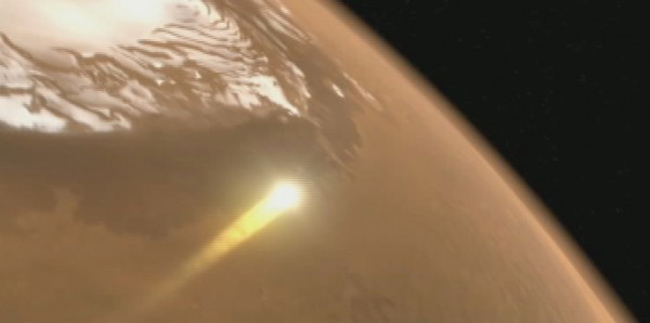How NASA’s Phoenix Will Land on Mars

NASA's Phoenix Mars Lander aims to not flame out when it descends to thearctic surface of the red planet in less than two weeks.
The new Martian probe will try to avoid the fate of its crashedpredecessor, NASA?s Mars Polar Lander, when deploying a parachute and brakingrockets to slow its plunge and make a successful three-point landing.
"This isnot a trip to grandma's house,? said Ed Weiler, associate administrator ofNASA?s Science Mission Directorate at the agency?s headquarters in Washington, D.C. ?Putting a spacecraft safely on Mars is hard and risky.?
Phoenix managers refer to the probe?s descent as ?seven minutes ofterror? that will define the future of the spacecraft?s $420-million mission.The robotic arm-equipped spacecraft is due to land near the Martian north poleon May 25 to study nearby water ice and determine if the region was oncehabitable for primitive life.
"Hopefullythe outcome will be different from the Mars Polar Lander outcome," saidRob Grover, NASA engineer at the Jet Propulsion Laboratory in Pasadena, Calif.
Mars PolarLander (MPL) entered the Martian atmosphere near the planet?s south pole in1999, but a software glitch caused a premature shutdown of the spacecraft'sengines. It crashed while falling at 50 mph (80 kph) instead of making a softlanding. NASA has worked since then to ensure Phoenix doesn?t suffer the same fate.
"Thenumber one cause was the faulty indicator on touchdown sensor," Grovertold SPACE.com, adding that the sensor falsely told the MPL thatit had already landed.
Breaking space news, the latest updates on rocket launches, skywatching events and more!
Engineershave since corrected the software issue and made the overall system more robustto avoid future errors.
?We feellike we have adequately tested this vehicle,? Phoenix project manager Barry Goldstein said in a Tuesday missionbriefing, but added that there is always room for the unexpected. ?We fire 26pyrotechnic events in the last 14 minutes of this vehicle, and every one ofthose has to go off as planned?We?re very hopeful for success on the 25th.?
PhoenixUser?s Guide for Mars Arrival
The exactfate of the lost MPL remains somewhat uncertain because that probe had no wayof communicating with Earth once it entered the Martian atmosphere. That won'tbe the case for Phoenix, which has a small crowd of threeMars orbiters to watch and relay information from the spacecraft throughoutlanding.
ForGoldstein, it is the three-second communications gap between Phoenix?s departure from its cruise stageand the first signals to its relay network that gives him the shivers. If Phoenix fails to land successfully, anysignals just before landing will prove vital in learning its fate, he said.
?Gettingthat communications down is the important thing,? Goldstein said. ?That will bethe three seconds that I?m really biting my nails over.?
Awraparound antenna sits on Phoenix's back-shell, capable of transmitting anultra-high frequency signal to Earth via NASA?s Mars Reconnaissance Orbiter(MRO) or Mars Odyssey spacecraft Europe?s Mars Express orbiter is also on callin case of an emergency, mission managers said.
"Thisis the first time for any Mars landing having orbital relay communications forboth landing and being on the surface," Grover said.
Phoenix will descend and land much the sameway that MPL was meant to, plunging into the Martian atmosphere at about 13,000mph (21,000 kph). That's similar to respective 2004 descents of NASA?s Spiritand Opportunity rovers, though Phoenix?s arrival would mark first poweredlanding on Mars since NASA?s Viking missions of the 1970s
The probecombines new technology with proven methods for landing, including anApollo-era Earth entry software algorithm to guide the spacecraft's earlydescent into the Martian atmosphere.
AViking-era parachute is designed to open once Phoenix falls within 7.8 miles (12.6 km) above Mars, creating dragto slow the spacecraft as it screams through the atmosphere at supersonicspeed. The probe?s landing radar should begin giving altitude and velocity ofdescent as Phoenix nears the surface, so that theonboard computer can make any necessary landing adjustments.
"Bythe time you get the parachute opening, there can be significant errors inpositioning on order of kilometers," Grover said. "So that's whereradar is critical, because it turns on and gets fresh knowledge ofaltitude."
VerticalMartian lander
Two minutesafter the parachute deployment, Phoenix will have descended to approximately 0.6 miles (1 km) above thesurface. The lander should then jettison its backshell and freefall for half asecond before lighting up its engines.
Nine of thetwelve engines will pulse furiously 10 times per second — an effect Groverlikened to "coming down on a jackhammer." The three non-pulsingengines should fire steadily to help ensure added stability.
?Justbefore touchdown, we actually pirouette the vehicle,? Goldstein said, addingthat the move will aid Phoenix?s vital solar arrays. ?We actuallyturn it so we maximize solar exposure.?
Navigatorsat JPL can upload fresh orders to Phoenix?s guidance computer up to three hours before landing, in case courseadjustments are required. However, Grover and other NASA engineers will only beable to stand by and trust in their spacecraft technology once the Mars landerbegins its descent.
"We'vedone all that's humanly possible," Grover said.
- Video: NASA's Phoenix: Rising to the Red Planet
- Video: Looking for Life in All the Right Places
- The Top 10 Martian Landings of All Time
Jeremy Hsu is science writer based in New York City whose work has appeared in Scientific American, Discovery Magazine, Backchannel, Wired.com and IEEE Spectrum, among others. He joined the Space.com and Live Science teams in 2010 as a Senior Writer and is currently the Editor-in-Chief of Indicate Media. Jeremy studied history and sociology of science at the University of Pennsylvania, and earned a master's degree in journalism from the NYU Science, Health and Environmental Reporting Program. You can find Jeremy's latest project on Twitter.
